Why we love the gentle and patrician Clumber spaniel
Favoured throughout history by royalty, Clumber spaniels are still treasured for their tenacity and temperament, discovers Matthew Dennison.
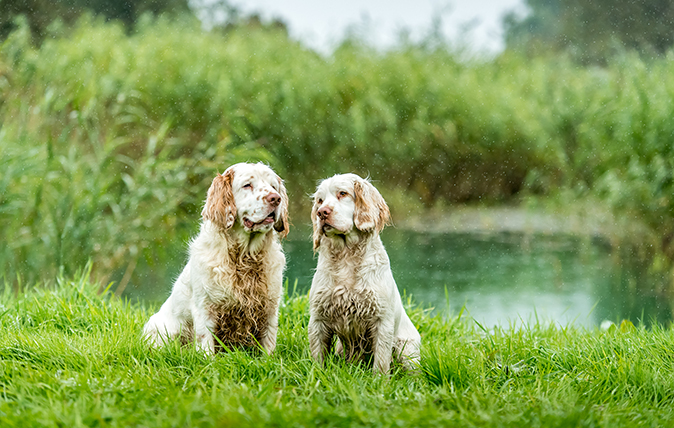

For the Clumber spaniel, 2017 has been a year to celebrate. The fortunes of these handsome, muscular, lemon- and orange-marked white gundogs have languished since the Second World War. Annual puppy registrations currently hover around the 200 mark. By comparison, The Kennel Club registers some 30,000 cocker and springer spaniel puppies every year.
This spring, however, for the first time since 1911, a Clumber spaniel won an any variety field trial. When three-year-old Midori Diamond Huddlestone, known as Rigg, triumphed over 15 springers in the novice stake of the Tyne Tees and Tweed Field Trial Association, he became the first Clumber any variety field-trial winner for more than 100 years. Press coverage of Rigg’s success added to high-profile owners, including The Princess Royal, president of the Working Clumber Spaniel Society, and the Archbishop of Canterbury, whose four-year-old Clumber is called Bramble, has contributed to renewed interest in this historic British breed.
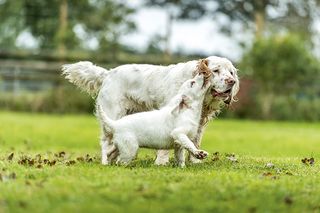
For Clumber aficionados, Rigg’s victory came as no surprise. His owner, committee member of the Working Clumber Spaniel Society John Smith-Bodden, points to the breed’s ‘fantastic noses’ and their dogged thoroughness in hunting out their quarry, an assessment seconded by the Marquess of Salisbury, who currently works his third successive Clumber spaniel, Lincoln. ‘They have enormous stamina and wonderful scenting qualities,’ Lord Salisbury tells me. ‘They also typically show none of the over-excitement or flibbety-jibbertiness of some springers.’
Instead, these dogs are reliable and sure-footed, noted for their gentle mouths and gentle dispositions, their quietness in the field, tenacity in working through dense cover and, above all, their affectionate natures. ‘In the field, they’re totally focused on the task in hand,’ comments Charlotte Chilvers, whose 11-year-old Bumble and four-year-old Hebe are working gundogs as well as pets for her two young sons, Robert and Oliver. ‘They are such kind dogs, so loving – a joy to be around. They seem to understand the dynamic of family life. Although my husband works them, they’re not one-person dogs. The children spend more time on the dogs’ beds than anywhere else in the house.’

Today’s Clumbers are descendants of the stocky, marmalade- and liver-splashed white spaniels bred and trained for the 2nd Duke of Newcastle by gamekeeper William Mansell, at Clumber Park in Nottinghamshire, in the last quarter of the 18th century. A handful of these dogs is visible in The Return from Shooting, a painting of 1788 by Francis Wheatley, in which the Duke, William Mansell and Newcastle’s friend Col Litchfield are depicted in an autumn landscape with gamekeepers and springer-type spaniels.
Tradition invests these first Clumbers with a French pedigree. Their progenitors were reputedly dogs given to the Duke by the duc de Noailles, a picturesque tradition unsubstantiated by material in the papers of either the Newcastle or Noailles families.
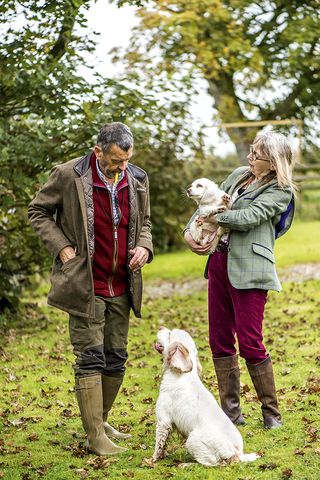
Whatever the truth of their origins – and it may be, as has been suggested, that the distinctive heavy doughtiness of the Clumber shape arose through the inclusion of some hound blood in Mansell’s breeding programme – the breed’s early popularity is attributable to Newcastle’s sponsorship: dogs from Clumber Park made their way into the Duke of Portland’s kennels at nearby Welbeck Abbey and those of the Foljambe family at Osberton Hall near Worksop. Members of the Foljambe family afterwards bred some of the first Clumbers entered in dog shows.
Sign up for the Country Life Newsletter
Exquisite houses, the beauty of Nature, and how to get the most from your life, straight to your inbox.
In her journal for October 1840, Queen Victoria recorded a walk in the park at Windsor with Prince Albert and ‘his seven fine Clumber Spaniels’: ‘We went into the Slopes… in order that I should see how the dogs found out the game; they are such nice, dear dogs.’ The Prince bequeathed his fondness for the breed and his habit of working them as a pack to his eldest son and grandson; Edward VII and George V, both keen shots, each kept a number of Clumbers in the kennels at Sandringham.
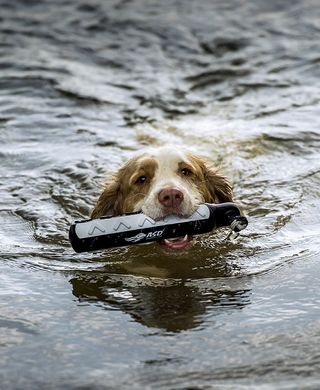
In one contemporary account, it was the breed’s suitability for working in groups that particularly attracted George V, his favour ‘largely attributable to their special suitability for the covert shooting in which His Majesty delights and to the fact that the clumber, almost alone of shooting dogs, can be worked in packs’.
Dog painter Reuben Ward Binks placed the King’s favourite, Sandringham Susan, in the centre of his charming George V’s Clumber Spaniels at Sandringham, a portrait of six royal Clumbers painted in 1930.
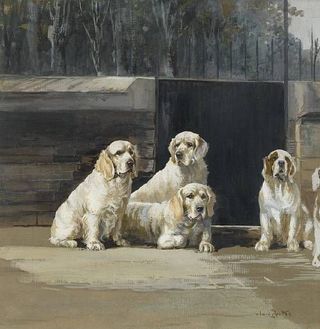
Today, few owners are able to accommodate packs of working dogs on this scale. In addition, those Clumber breeders who preserved the breed from extinction in the years after the Second World War contributed to the development of an increasingly heavy, slow-moving spaniel lacking athleticism and unsuited to working coverts. Without any working purpose, the breed experienced a sharp decline in popularity from which it has yet to recover fully.
Today’s owners all agree that the Clumber deserves to be more widely kept, both as a working dog and a pet. Lord Salisbury admires the breed’s ability to wriggle through undergrowth to put up birds and their stubbornness in running down their prey: ‘They’re not the intellectual stars of the canine world, but they’re pretty grounded and they have delightful personalities. And, as I grow older, Lincoln proceeds at something nearer my own stately pace.’
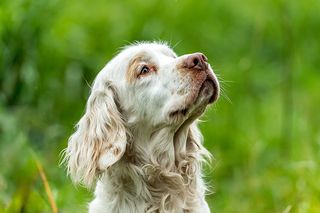
Owner Claire Griffith, who works her four-year-old rescue Clumber Finn on her husband’s North Wales estate, admires his fixity of purpose. ‘He works very well in dense thicket and does quite a lot of putting up,’ she explains. ‘He works much more carefully than other spaniels, picking up birds that other dogs miss and working steadily and slowly.’
Mrs Griffith identifies Finn’s complete lack of aggression as a typical Clumber trait. His slow determination is also typical, although, for some owners, it comes close to stubborn-ness and Mr Smith-Bodden suggests that puppies can be slower to train as working dogs than other spaniel types.
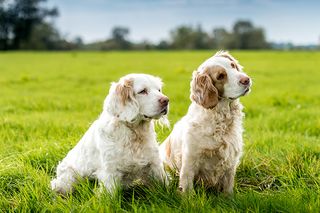
Mr Smith-Bodden and his wife, Jane, currently have six Clumbers, including Rigg, whose performance in the field he describes as ‘poetry in motion’. Beyond the dogs’ adroitness in putting up or retrieving partridge, pheasant and duck and their gentleness, loyalty and affection, the Smith-Boddens, like other owners, admire the Clumber’s gorgeous good looks. Mrs Griffith waited many years before she was able to acquire one of her own. ‘Somewhere, there is a 19th-century painting of Clumbers in the heather,’ she remembers. ‘I’d always rather wanted one.’ The long-awaited Finn, rehomed from a keeper on Anglesey, is a ‘very beautiful white and ginger’.
It’s not entirely true that Clumbers are silent dogs. Despite their quietness when working, they have a distinctive singsong woo woo bark that Mrs Chilvers tells me delights her sons and with which Clumbers typically greet their owners each morning. It seems characteristic of these gentle, patrician spaniels that even their bark should be mellifluous and winning.
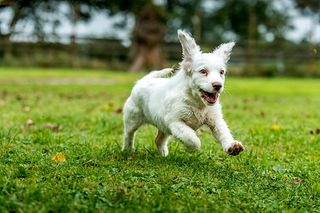
Crazy about Clumbers
- Papers belonging to the Dukes of New-castle refer to Clumber spaniels as ‘the Duke’s breed’ or ‘Mansell’s breed’, after gamekeeper William Mansell
- Despite the tradition of the breed’s French origin, historians suggest the Clumber derived from a cross between British and Spanish or Alpine spaniels or from the inclusion of a basset hound in early breeding
- Current owners include biographer and novelist Max Egremont of Petworth House. Among paintings at Petworth is an early-19th-century portrait by Thomas Phillips of Lord Egremont’s forebear, the 3rd Earl of Egremont, alongside his Clumber spaniel
- Early shooting guides suggested that, on account of their quietness, Clumbers be ‘worked with bells attached to their collars, as by the help of these they can gradually drive the game forward’. Their quietness was described as ‘of great value, as they can work up close enough to a pheasant to almost clutch him’
- In 1909, the future King George V bought, from Fabergé's London store, a Chalcedony sculpture (with red ruby eyes) of a favourite Clumber, Sandringham Lucy, for £102

Fabulous Frenchies: Vive le bulldog français!
Sacrebleu! It seems that Britain’s top dog is a French bulldog.
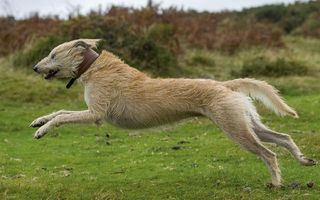
For the love of lurchers
We discovers why lurchers are one of life's guilty pleasures.

Credit: Alamy
Cocker spaniel versus springer spaniel: What owners need to know
Which is the more popular spaniel, the springer or the cocker? Shooting Times's David Tomlinson weighs up the pros and
Bringing the quintessential English rural idle to life via interiors, food and drink, property and more Country Life’s travel content offers a window into the stunning scenery, imposing stately homes and quaint villages which make the UK’s countryside some of the most visited in the world.
-
 Two-thirds of use buy a house and immediately set about refurbishing it
Two-thirds of use buy a house and immediately set about refurbishing itWe spend more buying our houses than on anything else in our lives — yet the first thing we do on moving in is set about changing the place. Annabel Dixon takes a look at what we do and why.
By Annabel Dixon Published
-
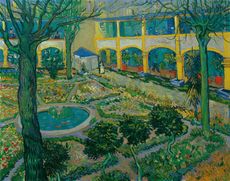 Dawn Chorus: Audrey Hepburn’s Swiss villa hits the market for £17 million and research reveals that looking at art can, quite literally, help you live longer
Dawn Chorus: Audrey Hepburn’s Swiss villa hits the market for £17 million and research reveals that looking at art can, quite literally, help you live longerEverything you need to know today: The Swiss home that Audrey Hepburn lived in for 30 years prior to her death is for sale, those who regularly engage with art have a 31% lower risk of dying early and an iconic Palm Beach hotel teams up with interior designer Ashley Hicks.
By Rosie Paterson Published
-
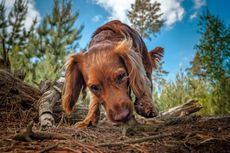 You've got peemail: Why dogs sniff each other's urine
You've got peemail: Why dogs sniff each other's urineEver wondered why your dog is so fond of sniffing another’s pee? 'The urine is the carrier service, the equivalent of Outlook or Gmail,' explains Laura Parker.
By Laura Parker Published
-
 Seven true ghost stories from a century of Country Life
Seven true ghost stories from a century of Country LifeOver the course of Country Life's 125-year history, dozens of readers have shared their tales of ghosts. Here we've picked out seven of the most fascinating.
By Country Life Published
-
 10 of Scotland’s most magical white sand beaches
10 of Scotland’s most magical white sand beachesWhat better day to celebrate some of Scotland's most stunning locations than St Andrew's Day? Here's our pick of 10 of the finest white sand beaches in the country.
By Country Life Published
-
 The BBC Proms are the most ambitious, eclectic and successful classical music festival in the world — and we should celebrate them
The BBC Proms are the most ambitious, eclectic and successful classical music festival in the world — and we should celebrate themThe Proms are a great British institution and a remarkable success story, says Country Life's cultural commentator Athena.
By Country Life Published
-
 Country Life's top 10 dog stories of 2022
Country Life's top 10 dog stories of 2022From beautiful breeds to superb advice from our training expert, these are our best dog-related stories of the last 12 months.
By Toby Keel Published
-
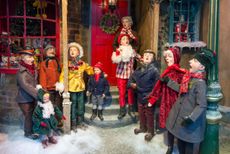 Who wrote the Christmas Carols we know and love? 11 songs and their stories, from Silent Night to Good King Wenceslas
Who wrote the Christmas Carols we know and love? 11 songs and their stories, from Silent Night to Good King WenceslasMany of our best-loved and most moving Christmas carols started life as poems in search of a tune. Andrew Green uncovers the writers whose works were nearly forgotten, yet are now imprinted on the memory.
By Country Life Published
-
 Dog recall training: Six tips from champion dog trainer Ben Randall
Dog recall training: Six tips from champion dog trainer Ben RandallTraining your dog is not easy — and with the huge recent rise in dog ownership, it's never been a better time to share the best advice. A-list celebrity dog-trainer Ben Randall solves your canine dilemmas.
By Ben Randall Published
-
 Crate training a puppy: Six tips from expert dog trainer Ben Randall
Crate training a puppy: Six tips from expert dog trainer Ben RandallPuppy crate training can be tricky, yet it can pay dividends in all sorts of ways — even making puppy toilet training easier. Award-winning dog trainer Ben Randall explains how to get it right from the start — and we do mean the VERY start.
By Ben Randall Published